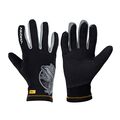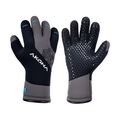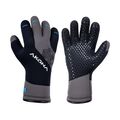- Home
- Thermal Protection
- Gloves
Gloves
Gloves
Gloves come in many thicknesses and sizes and for a novice person is it tough to figure out just what you need. There are a couple of features that you should be looking at when it comes to gloves. Below are some of the more important deciding factors. Thickness Gloves come in everything from 1mm to 7mm and above. The thicker the MM (millimeter) the warmer the glove is going to be. For warmer waters most divers go with a 1 to 3mm glove, for temperate 3 to 5mm and for colder waters 5 to 7mm. This is not a hard and fast rule as everyone out there is different. Sizing This is the toughest part. It is always better to have a glove a little tighter than looser. The reason behind this is Boyles Law. You have to remember that when the pressure at depth pushes on the glove the glove will get looser from the neoprene compressing. If the glove is too loose it will flush water if it flushes water your hands will get cold. Features This is what really makes the difference. Stretch Fabric This fabric is easier to get on and off and feels great on. The only down side of this is that fabric can tear or rip easier. Most people prefer this type of glove Kevlar Kevlar on the palms and finger tips makes a glove last substantially longer the down side is that you loose dexterity. Glued Seams This is not seen on many gloves but is really nice. The sealed glove keeps flushing down to the minimum. John’s Quick Tips; Gloves tough to get on. Here is a great tip that will make your life a lot easier. You can buy suit juice or make your own out of dish detergent. If you decide to make your own you just need a couple small squirts of dish detergent and then fill the bottle with water. All you do now is squirt a pile of this sudsy slippery liquid inside your gloves and you will slip right in. This actually works great for your second dive and is great on wetsuits too! Gloves showing wear? This is a great tip that works on all the spots of your gloves that continue to wear. All you do is mix up aquaseal and cotol into liquid that is thicker than water but can be applied with a brush. Now take an acid brush and coat the glove lightly in the wear areas. This is one time when thicker is not better. The reason behind is dexterity again. The thinner aquaseal will suck into the pours and make the glove more abrasion resistant. You only want a light coat a thick coat will cause the glove to be stiff and you will be buying a new pair, which of course makes me happy and you sad.
 Loading... Please wait...
Loading... Please wait...





